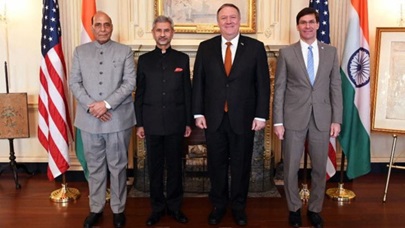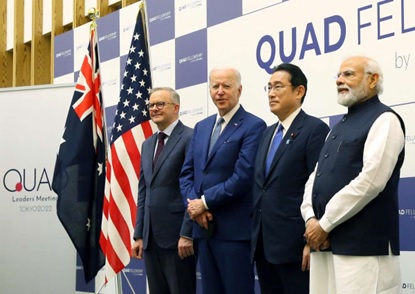
India US Strategic Partnership
Indo-US Strategic Alliance For Peace And Stability In The Indo-Pacific Region
The India US strategic partnership is a significant bilateral relationship between India and the United States. The partnership covers a wide range of areas, including defense, trade, energy, education, and counterterrorism. In recent years, the relationship between India and the US has deepened significantly.
The two countries have signed a number of important agreements, including the US-India Civil Nuclear Agreement, the Defense Framework Agreement, and the India-US Strategic Partnership Forum.
The strategic partnership has been driven by a number of factors, including India’s emergence as a major economic and military power in the region, the growing importance of the Indo-Pacific region in global affairs, and the shared democratic values of India and the US.
India US Two Plus Two Dialogue

One of the key areas of cooperation between India and the US is defense. The two countries regularly hold joint military exercises and have signed several defense agreements, including the Logistics Exchange Memorandum of Agreement (LEMOA) and the Communications Compatibility and Security Agreement (COMCASA).
These agreements allow the two countries to share military technology and intelligence and enhance their defense capabilities. Another important aspect of the strategic partnership is trade.
India US Joint Military Exercise

India and the United States have conducted several joint military exercises over the years. These exercises are designed to improve interoperability and enhance the capabilities of the two countries’ armed forces. One such exercise is the Yudh Abhyas, a bilateral army exercise between the Indian Army and US Army.
In addition to Yudh Abhyas, the Indian and US militaries have also conducted other joint exercises, such as Vajra Prahar (special forces exercise), Malabar (naval exercise), and Cope India (air force exercise). These exercises demonstrate the growing military-to-military cooperation between the two countries.
India US Trade And Commerce
India and the US are each other’s top trading partners, with bilateral trade valued at over $150 billion in 2019. The two countries have signed a number of trade agreements, including the US-India Trade Policy Forum and the Bilateral Investment Treaty.
At present, the India-US strategic partnership is seen as a significant development in global politics, with the potential to shape the future of the Indo-Pacific region and beyond.
India US Strategic Partnership
Objectives Of Indo-US Strategic Partnership
The main objective of the India-US strategic partnership is to promote peace, stability, and prosperity in the Indo-Pacific region and beyond. The partnership is based on shared democratic values, mutual interests, and a commitment to the rule of law.
India and the United States have worked closely together on a range of issues, including defense and security, economic and trade relations, science and technology, energy, and people-to-people ties. The partnership has also played a significant role in shaping the regional and global agenda on issues such as climate change, counterterrorism, and non-proliferation.

One of the key priorities of the strategic partnership is to enhance defense and security cooperation, including joint military exercises, defense technology transfers, and collaboration in areas such as counterterrorism and maritime security. The partnership also seeks to deepen economic ties through increased trade and investment, as well as cooperation in areas such as infrastructure development and energy security.
The India-US strategic partnership is aimed at promoting a free, open, and inclusive Indo-Pacific region, where all countries can prosper and pursue their interests in a peaceful and stable environment.
Significance Of India US Strategic Partnership
India-US strategic partnership refers to the deepening of cooperation and collaboration between India and the United States across a range of areas such as defense, trade, energy, technology, and security. The partnership between the two countries has seen significant growth in recent years, driven by shared democratic values, economic interests, and security concerns.
- Economic Benefits: India-US strategic partnership can create opportunities for increased trade and investment, leading to job creation and economic growth in both countries.
- Countering China: The partnership can be a significant counterweight to China’s growing economic and military influence in the Indo-Pacific region.
- Security Cooperation: India and the US have increased cooperation on defense and counterterrorism, enhancing regional and global security.
- Technology and Innovation: The partnership can drive innovation and collaboration in fields such as science, technology, and research, which can benefit both countries.
- Climate Change: Both countries can work together to address the global challenge of climate change and promote clean energy.
India US Strategic Partnership Challanges
India and the United States share a complex and multifaceted relationship. While the two countries have had their differences in the past, they have also made significant strides in deepening their cooperation in a range of areas, including trade, defense, and technology.
Despite the challenges, there are many areas where India and the US can work together to achieve common goals. By building on their shared values and interests, they can forge a stronger and more productive partnership for the future.
Here are some ways in which India and the US can work together despite the challenges:
- Historical Tensions: India and the US have had a complicated relationship in the past, including differences over nuclear weapons, trade, and human rights issues.
- Domestic Politics: Domestic politics in both countries can influence the trajectory of the partnership, as seen in the case of the India-US civil nuclear agreement, which faced significant opposition in both countries.
- Regional Tensions: The partnership can be complicated by regional tensions, such as the conflict between India and Pakistan or the ongoing conflict in Afghanistan.
- Divergent Strategic Priorities: India and the US may have divergent strategic priorities in certain areas, which can lead to differences and disagreements.
India US Foundation Agreements
The India-US Foundation has signed several agreements over the years, four of which are commonly referred to as the foundational agreements. Some of these foundational agreements between India and the United States that govern their defense and security cooperation.
These agreements demonstrate the deepening of India-US defense ties and have strengthened the strategic partnership between the two countries.
These agreements are:
1. GSOMIA
General Security of Military Information Agreement
GSOMIA (General Security of Military Information Agreement) signed in 2002. This agreement allows for the sharing of classified military information between India and the United States. This agreement helps to improve communication and cooperation between the two countries’ armed forces.
2. COMCASA
Communications Compatibility And Security Agreement
COMCASA (Communications Compatibility and Security Agreement) signed in 2018. This agreement enables secure communication between the two countries’ military forces by providing a framework for the transfer of communication security equipment and the encryption of communication.
3. LEMOA
Logistics Exchange Memorandum Of Agreement
LEMOA (Logistics Exchange Memorandum of Agreement) signed in 2016. This agreement allows for mutual access to designated military facilities for the purpose of refueling and resupplying of ships, aircraft, and other military assets. This agreement aims to enhance the logistical support for joint military operations and training exercises between India and the United States.
4. BECA
Basic Exchange and Cooperation Agreement
BECA (Basic Exchange and Cooperation Agreement) signed in 2020. This agreement allows for the sharing of geospatial information, including maps and satellite imagery, between the two countries’ armed forces. This agreement helps to improve the accuracy of missile systems and enhances maritime situational awareness for the two countries.
India US Military Alliance And China Factor
The India-US strategic partnership has been growing in recent years, driven by shared democratic values, economic interests, and security concerns. The partnership has been cemented through various bilateral agreements, including the US-India Civil Nuclear Agreement and the US-India Defense Framework Agreement.
The partnership has also been strengthened through multilateral initiatives such as the Quadrilateral Security Dialogue (Quad), which includes the US, India, Japan, and Australia. The Quad aims to promote regional stability, free and open trade, and a rules-based order in the Indo-Pacific region.
One significant factor driving the India-US strategic partnership is the rise of China. Both India and the US have concerns about China’s increasing assertiveness in the region, including territorial disputes, military build-up, and economic coercion.

India has had a long-standing territorial dispute with China along the Line of Actual Control (LAC) in the Himalayas, which has escalated into deadly clashes in recent years. The US has also been critical of China’s actions in the South China Sea, where it has built and militarized artificial islands and claims sovereignty over vast swathes of territory.
The India-US strategic partnership serves as a counterbalance to China’s growing influence in the region. It has also enabled India to diversify its strategic options and reduce its dependence on traditional partners such as Russia.

However, India’s relationship with the US is not without challenges. India has historically maintained a non-aligned foreign policy, and there is still some reluctance within the country to align too closely with the US. Additionally, the US has often been critical of India’s human rights record and treatment of religious minorities.
Despite these challenges, the India-US strategic partnership remains a crucial component of the global geopolitical landscape and will continue to be shaped by the evolving dynamics of the region.



